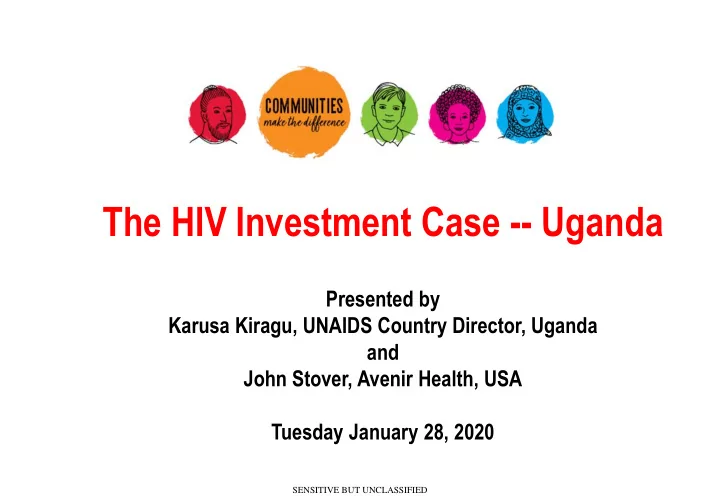

The HIV Investment Case -- Uganda Presented by Karusa Kiragu, UNAIDS Country Director, Uganda and John Stover, Avenir Health, USA Tuesday January 28, 2020 SENSITIVE BUT UNCLASSIFIED
What is an HIV Investment Case? • The HIV Investment Case is a value proposition which describes how the Uganda government, working together with its partners and stakeholders, will help to improve the HIV response over the next 10 years. • It describes how a stronger, more efficient and results-oriented government will serve the people of Uganda to achieve established targets. • It makes the argument why the solutions Uganda proposes, will be able to solve the problem based on: • Understanding the HIV situation • ‘Designing efficient programs • Delivering at scale and • Sustaining for impact with adequate funding. SENSITIVE BUT UNCLASSIFIED
How is it being done? • Leadership: Uganda AIDS Commission and the AIDS Control Program • Advisors: Technical working group comprised of several thematic areas (HIV Prevention; Care and Treatment; Social Support; Systems Strengthening); guided by a steering committee • Expertise: Will be prepared by the same team that did the last HIV Investment Case for Uganda • Consultations : Participatory consultations with stakeholders • Process : Modelling various intervention scenarios and projecting HIV outcomes to find the most optimal for the investment SENSITIVE BUT UNCLASSIFIED
What will be the product? The final product is a document which explains: 1. What are the results of the current investments? 2. How much should Uganda spend in the future and what will Uganda get? 3. What needs to be improved? 4. Where will the money come from? SENSITIVE BUT UNCLASSIFIED
How will it be used? 1. To inform the HIV National Strategic Plan 2. To inform the Global Fund application 3. To support other financing dialogues SENSITIVE BUT UNCLASSIFIED
Modeling to Support the Development of the NSP and the Investment Case 28 January 2020 SENSITIVE BUT UNCLASSIFIED
National HIV and AIDS Strategic Plan 2015/16 – 2019/20 Zero new HIV infections, zero HIV- related mortality, zero stigma Social support and Systems Prevention Care and treatment protection strengthening SENSITIVE BUT UNCLASSIFIED
Modeling for the NSP Services provided • Intervention Inputs • Population group • Pop data • Surveys Model calculations • Program data • Need for services • Unit costs • Behaviors Outputs • Transmission • New infections • Progression Targets • AIDS deaths • Mortality • Prevention • Cost • Tx cascade • Cost- • Social enablers effectiveness • Efficiencies SENSITIVE BUT UNCLASSIFIED
Constant Coverage New HIV Infections AIDS-Related Deaths 90,000 90,000 80,000 80,000 70,000 70,000 60,000 60,000 50,000 50,000 40,000 40,000 30,000 30,000 20,000 20,000 10,000 10,000 0 0 2010 2015 2020 2025 2030 2010 2015 2020 2025 2030 Constant Constant SENSITIVE BUT UNCLASSIFIED
Achieving global targets New HIV Infections AIDS-Related Deaths 90,000 90,000 80,000 80,000 70,000 70,000 60,000 60,000 50,000 50,000 40,000 40,000 30,000 30,000 20,000 20,000 10,000 10,000 0 0 2010 2015 2020 2025 2030 2010 2015 2020 2025 2030 Constant Targets Constant Targets Target scenario achieves UNAIDS updated Fast-Track targets. Stars represent 75%/90% reduction from 2010 to 2020/2030. SENSITIVE BUT UNCLASSIFIED
Epidemic transition: Targets achieved Incidence – Mortality Ratio Incidence – Prevalence Ratio 1.8 0.09 1.6 0.08 1.4 0.07 1.2 0.06 1.0 0.05 0.8 0.04 0.6 0.03 0.4 0.02 0.2 0.01 0.0 0 2010 2012 2014 2016 2018 2020 2022 2024 2026 2028 2030 2010 2012 2014 2016 2018 2020 2022 2024 2026 2028 2030 Ratio Target Ratio Target SENSITIVE BUT UNCLASSIFIED
Importance of addressing social enablers New HIV Infections AIDS-Related Deaths 90,000 90,000 80,000 80,000 70,000 70,000 60,000 60,000 50,000 50,000 40,000 40,000 30,000 30,000 20,000 20,000 10,000 10,000 0 0 2010 2015 2020 2025 2030 2010 2015 2020 2025 2030 Constant Targets No Social Enablers Constant Targets No Social Enablers Social enablers: Programs to address stigma, gender-based violence, decriminalization, human rights SENSITIVE BUT UNCLASSIFIED
Resources Needed $1,400 Millions $1,200 $1,000 Funding $800 gap $600 $400 $200 $0 2020 2021 2022 2023 2024 2025 2026 2027 2028 2029 2030 Base Targets SENSITIVE BUT UNCLASSIFIED
Closing the funding gap: optimizing allocation and improving implementation efficiency New HIV Infections 45,000 40,000 35,000 Constant coverage 30,000 Constant expenditures 25,000 (optimized) 20,000 Implementation efficiencies 15,000 Targets achieved 10,000 5,000 0 2020 2021 2022 2023 2024 2025 2026 2027 2028 2029 2030 Optimized = Current spending optimized for maximum prevention Implementation efficiencies = Optimized plus implementation changes to reduce costs SENSITIVE BUT UNCLASSIFIED
NSP Components Prevention Treatment Social enablers • Condoms • HIV testing services • Reduce stigma • VMMC • Linkage to care • Prevent gender-based • PMTCT • ART delivery violence • PrEP • Adherence support • Decriminalize behaviors • PEP • Combination Social protection System strengthening prevention for key • Governance and support populations • Financial sustainability • Human rights • Combination • Human resources • OVC prevention for AGYW • Service delivery • Services for priority • Research populations SENSITIVE BUT UNCLASSIFIED
Recommend
More recommend